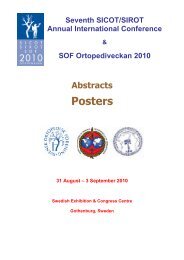sicotnews
sicotnews
sicotnews
Create successful ePaper yourself
Turn your PDF publications into a flip-book with our unique Google optimized e-Paper software.
Winter scene in Davos<br />
In 1929, the Swiss chapter of SICOT was founded. This<br />
became the “Free association of Swiss orthopaedists”<br />
which was renamed in 1953 the “Association of Swiss<br />
Orthopaedists” and became in 1963 formally the Swiss<br />
Society of Orthopaedics and more recently the Swiss<br />
Society for Orthopaedics and Traumatology (SSOT/SGOT).<br />
Today the Swiss Society of Orthopaedics and Traumatology is<br />
over 700 members strong, dispersed throughout the regions<br />
of Switzerland where four national languages coexist. All Swiss<br />
Society meetings are multilingual, speakers using their own<br />
mother tongue and expecting to be understood by their<br />
listeners.<br />
The Swiss Society has thus grown from its status as a<br />
chapter of SICOT into a strong professional and academic<br />
organisation.<br />
The goal of the Society is to oversee postgraduate education<br />
programmes leading to the orthopaedic specialist diploma. The<br />
Society is also responsible for a yearly congress attracting over<br />
1,000 attendees each year and a national day of postgraduate<br />
teaching. The Swiss registry for implants is a major project in<br />
which the Society has invested much effort and means.<br />
The development of modern orthopaedics and traumatology is<br />
strongly linked with Switzerland. Because of a robust precision<br />
mechanics industry manufacturers could provide the AO group,<br />
founded in 1958 by Maurice E. Müller of SICOT fame, with their<br />
innovative implants.<br />
Geneva: churches, banks and watches<br />
The evolution of the Orthopaedic Specialist<br />
There are 37 orthopaedic services in the 189 Swiss hospitals,<br />
of which five are the University Services of Geneva, Lausanne,<br />
Bern, Basel and Zurich. The Swiss orthopaedic specialist<br />
training programme involves a two-year basic surgical rotation,<br />
after which the resident has to pass a general surgery examination<br />
in the form of an MCQ. The resident can then embark on four<br />
years of orthopaedic and traumatology training. At the end of<br />
the training, and provided a surgical log of about 400 operations<br />
in all fields of orthopaedic surgery is fulfilled, the resident is a<br />
candidate for the qualifying examination. If successful the<br />
resident will be recognised as an orthopaedic specialist free to<br />
pursue an academic career, work in a regional hospital or enter<br />
private practice.<br />
The Jungfrau from Interlaken<br />
A Continuing Medical Education programme is available and a<br />
quota of points must be obtained by attending it. All training<br />
centres provide a curriculum, freely available on the internet,<br />
and used by the residents in training every year.<br />
Collaborative efforts with other international organisations<br />
The Swiss orthopaedic community interacts actively with<br />
SICOT and sends participating delegates for presentations to<br />
all major meetings. This interaction with international societies<br />
is considered vital to the development of Orthopaedics and<br />
Traumatology in Switzerland. The major Swiss training centres<br />
accept fellows from all over the world to further education and<br />
enhance contacts.<br />
Population: 7.6 million<br />
Location: Central Europe<br />
Surface area: 41,285 km²<br />
Official languages: German, French,<br />
Italian, Romansh<br />
Major religions: Catholic/Protestant<br />
Type of government: Parliamentary democracy<br />
No. of orthopaedic surgeons: 618 active members of the<br />
Swiss Orthopaedic Society<br />
No. of SICOT members: 1 Distinguished; 12 Active;<br />
14 Emeritus; 1 Associate<br />
SICOTNEWS | February 2010 - No. 121<br />
5
















